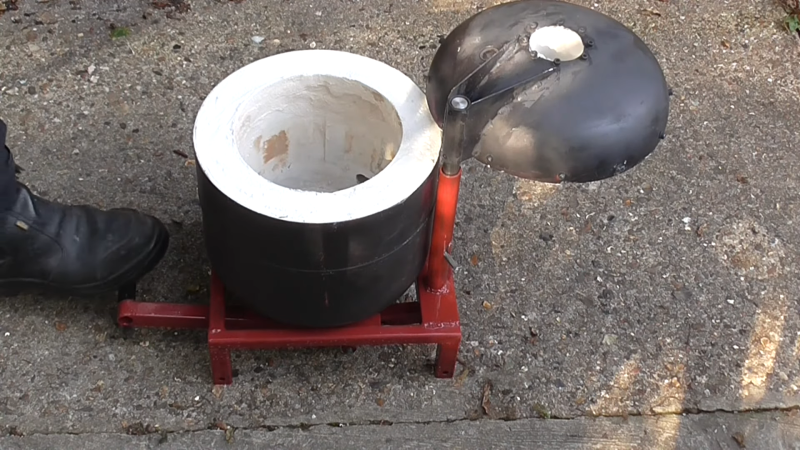Melting aluminum is actually pretty easy to do, which is why it’s such a popular metal for beginners at metal casting. Building a foundry that can melt aluminum safely is another matter entirely, and one that benefits from some of the thoughtful touches that [Andy] built into his new propane-powered furnace. (Video, embedded below.)
The concern for safety is not at all undue, for while aluminum melts at a temperature that’s reasonable for the home shop, it’s still a liquid metal that will find a way to hurt you if you give it half a chance. [Andy]’s design minimizes this risk primarily through the hands-off design of its lid. While most furnaces have a lid that requires the user to put his or her hands close to the raging inferno inside, or that dangerously changes the center of mass of the whole thing as it opens, this one has a fantastic pedal-operated lid that both lifts and twists. Leaving both hands free to handle tongs is a nice benefit of the design, too.
The furnace follows a lot of the design cues we’ve seen before, starting as it does with an empty party balloon helium tank. The lining is a hydrid of ceramic blanket material and refractory cement; another nice safety feature is the drain channel cast into the floor of the furnace in case of a cracked crucible. The furnace is also quite large, at least compared to [Andy]’s previous DIY unit, and has a sturdy base that aids stability — another plus in the safety column.
Every time we see a new furnace design, we get the itch to start getting into metal casting. And with the barrier to entry as low as a KFC bucket or an old fire extinguisher, why not give it a try? Although it certainly pays to know what can go wrong before diving in.
















Just FYI, in the US propane tanks for grills, etc. are typically the same “12 inch” diameter (likely 12.2 inch) as the helium tank he used.
AND if you plan to do nay flame work or grinding on a propane tank, first fill it with water and drain it.
Do you sell propane and propane accessories, by any chance? :)
Hey now, no flaming in this forum! Aggression inhibiters are mandated by CMC policy.
Otherwise, I’d offer you a light ;)
Love your automated bandsaw. And I assume you have to time the press and release of the foot peddle to let the momentum of the lid cause it to automatically open and close. Great job.
If I had infinite time I’ld love to try casting parts.
[Hand Tool Rescue] restored one similar to that about four years ago, https://www.youtube.com/watch?v=v7429aWOTF8
Yeah the saw was cool too.
I’d love to be casting my 3D prints but all that liquid metal really makes me nervous!
Start with melting first, casting is a whole’nother level
Look up pit furnace, it gives you an idea how easy it can be.
I tried it first with coal and a can as a cruisible to melt aluminum and sandcast it. And it was surprisingly easy!
You should thoroughly read the safety around casting/melting, a lot are obvious!
Zinc in the easiest metal to start with. My son casts parts in the fireplace in the lounge by lost-3D-print method
Field’s metal would be even easier as it melts at 62 C. Fun stuff. Doesn’t feel like casting without fierce heat though.
Foundries can be made more simply than using a propane container. Years ago I bought a small booklet from backyardmetalcasting.com on a flowerpot foundry. He also had a design using two buckets as well as a lot of great projects within the capability of novice metalcasters.
My own (very incomplete) foundry is a copy of Martin Catt’s elegant firebrick foundry that dispenses with the container completely by using easily-cut firebricks as the chamber, held together with angle iron:
https://backyardmetalcasting.com/guest_martin.html
Too bad in EU one would first have to apply for license to become a recycling company and meet all sorts of environmental requirements (like having required filters, keeping a register of scrap origin, paying taxes). Doing any kind of illegal metal smelting/recycling is probably enough for a police search warrant because it used to be popular with people stealing 3kV overhead power cables used on railroad.
What you wrote is just plain wrong. As long as you melt metals for your private pleasure, there are no regulations et all besides of common sense. If you do it commercially there are regulations like in every other country, i bet even your country has laws covering it, britbong.
just now realized it said flip top foundry. here I thought it was a safer method so you could wear flip flops while you were smelting.
That auto swing out mechanism he does by using a j cutout in the pipe, and inertia with the bolt in it as a track, was pretty ingenious. I also really liked his use of the 3D printed plug for a drain trough. Very nice build, really elegant.
Also- he does a great series on building a stepper syncronised gear hobbing machine- guy is really versatile. I highly recommend you watch that if you really want to make accurate gears. It’s well done
My instructable could be added to the list
https://www.instructables.com/Pizza-Sauce-Can-Furnace/